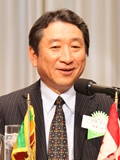Redevelopment of Marunouchi��Towards Creating New Values
May 15, 2013
Mr. Naoto Aiba
Executive Vice President, MITSUBISHI ESTATE Co., Ltd.
�� The restored Tokyo Station or the new Tokyo Central Post Office building is among the hottest topics today, while various plans are underway that include building a luxurious Japanese hot spring inn at the heart of Tokyo or a halfway train station between Narita and Haneda Air Ports. My speech today will focus on the background (��setting��) that led to the actual ��physical construction�� seen today.
The restored Tokyo Station or the new Tokyo Central Post Office building is among the hottest topics today, while various plans are underway that include building a luxurious Japanese hot spring inn at the heart of Tokyo or a halfway train station between Narita and Haneda Air Ports. My speech today will focus on the background (��setting��) that led to the actual ��physical construction�� seen today.
1. History of the Dai-maru-yu (Otemachi-Marunouchi-Yurakucho) District
��The Meiji Government was facing serious financial difficulties in 1890 to generate funds for military expenditures. The government decided to sell the Marunouchi area to private entity at an inflated price, to which no zaibatsu (industrial conglomerate) showed interest. Yanosuke Iwasaki, the second President of Mitsubishi, was the one and only who gave positive response. He purchased the area at the total price of 1.28 million yen back then, which was 3 times of the Tokyo City annual budget. He envisioned to reproduce the financial district of London right in the middle of Tokyo. In 1894, the Mitsubishi No.1 Building was constructed, which is currently turned into a museum.
��Completion of the Marunouchi Building in 1923 marked the new trend of replacing British-style brick buildings by American-style large-scale buildings. Redbrick cityscape was turned into modern buildings during the 1920s, and the floor space kept expanding along with the rapid economic growth that continued up to the 1970s.
2. Trends of area development
��As of 2013, the Dai-maru-yu District encompasses 109 buildings, with 230,000 employees and 4,200 business offices, including head offices of about 75 listed companies on the first section of the Tokyo Stock Exchange. Consolidated net sales of these companies total 124 trillion yen, equivalent to a quarter of Japanese GDP.
��The ��Council for Area Development and Management of Otemachi, Marunouchi and Yurakucho�� was established in 1988 where private land owners and leaseholders discussed how to make the area the world��s competitive business center. In 1996, the ��Advisory Committee on Otemachi-Marunouchi-Yurakucho Area Development�� was established as a public-private partnership (Tokyo Metropolitan Government, Chiyoda Ward, East Japan Railway Company and the aforementioned Council) that oversee the district��s redevelopment program. The Committee formulated the Guideline on the future vision, possible building rules and procedures for implementation in 2000, which was revised in 2005, 2008 and 2012. Redevelopment of the Marunouchi area entered its third phase around 2000 and one-third of the buildings have been constructed today. The whole project will take another 20 years to complete.
3. Vision and approach of area development
��A newspaper article ��Marunouchi at evening twilight�� in August 1997 shocked us engaged in the redevelopment initiative. Marunouchi was perceived to attract only the ��heavy and large�� companies where people commutated just to work on weekdays. Another shocking data of the 2012 IMD World Competitiveness Yearbook ranked Japan the 27th in the world, proving our declining competitive edge.
��We based our redevelopment project on the following four principles:
1) Accumulate and activate innovative corporate functions and supportive facilities.
2) Attract visitors through interactive urban tourism.
3) Develop disaster-resistant ��Business Continuity District.��
4) Develop an eco-friendly town.
��The redevelopment project must take into account roles to be played by business workers in the area. During the high-growth period, white-collar workers engaged in information processing. Today, they undertake knowledge creation. In this context, office facilities must address diversified needs towards creating new values. Town development itself must focus on how to enhance value creation.
��For example, constructing high-performance office buildings will not be enough. We must add multiple functions that support innovative workers, including day-care centers for working mothers, fitness clubs for health maintenance, or commercial facilities.
��The number of stores in the area has increased from 280 in 2002 to 820 in 2012 and served to attract numerous visitors and shoppers. The business town is transforming into a shopping town. Various events organized on weekends have doubled the number of visitors on Saturdays and tripled those on Sundays.
��The Marunouchi area is quite disaster-resistant, as its risk of liquefaction is relatively low and buildings are solidly-structured. Yet, each office and building is required to take due disaster prevention measures, such as stockpiling emergency foodstuffs and securing energy-resources for at least three days. In addition, various area-wide anti-disaster measures are taken to prepare for emergency situations.
��We must develop an eco-friendly town by CO2 emission reduction, without sacrificing productivity and comfort. Innovative lighting and air-conditioning technologies have been developed that achieve both cost reduction and quality improvement. Shin-Marunouchi Building has introduced the ��raw green electricity�� generated in the Tohoku region and reduced its annual CO2 emissions to nearly two-thirds of the usual level.
��
4. Conclusion
��Our goal is to ��create new values�� and to ��balance out elegance and vitality.�� ��Creating Shared Value (CSV)�� is a business concept advocated by Michael Porter a few years ago. I believe our redevelopment principles fit with this concept, as we aim to make profits through incorporating various needs and issues in the society into our daily business operations.
��There are multiple messages behind the phrase, ��becoming the most beautiful city in the world.�� We engage ourselves in constructing functional buildings, which I believe will enrich culture in a long run.